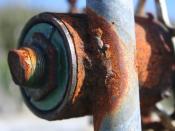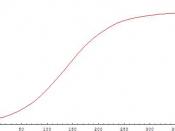Conclusions drawn from My Experiment on the effect of Enzyme concentration on the time taken for a reaction to occur
Interpretation
My graph shows a curved shape showing negative correlation. The results that I achieved were different to that of the classes. My results were on average higher than the class average results. For example at 1% concentration of urease solution our result was 1782 seconds for the reaction to occur while the class average result was 952 seconds. The graph tells us that when the concentration of urease increases the time the enzyme solution takes to completely react with all of the substrate decreases. The rate of reaction at 1% urease is a lot slower than the reaction that occurred at 5% urease, which was quite fast only taking 262 seconds. There is one anomaly in my results this was at 4% where it is quite a bit above the curve of best fit but other than that my results stuck pretty well to our curve of best fit.
My results indicate a negative correlation because of the fact that the amount of enzyme added will have an effect on reaction time. At 1% urease the reaction took 1782 seconds and at 2% urease the reaction took 795 seconds. The reason for this decrease is because of the increased concentration in urease solution there will be more active sites for the urea to react with in 2% urease. The more active sites will lead to more successful collisions between the enzyme and the substrate giving us more enzyme substrate complexes formed. During the experiment bonds are broken in the enzyme substrate complex and new ones are firmed so the substrate is converted into product, when this happens the solution turns green.
Our experiment went very well. I recorded...


